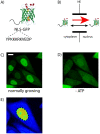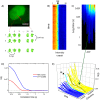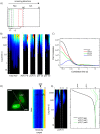In vivo imaging of single-molecule translocation through nuclear pore complexes by pair correlation functions
- PMID: 20454622
- PMCID: PMC2862743
- DOI: 10.1371/journal.pone.0010475
In vivo imaging of single-molecule translocation through nuclear pore complexes by pair correlation functions
Abstract
Background: Nuclear pore complexes (NPCs) mediate bidirectional transport of proteins, RNAs, and ribonucleoproteins across the double-membrane nuclear envelope. Although there are many studies that look at the traffic in the nucleus and through the nuclear envelope we propose a method to detect the nucleocytoplasmic transport kinetics in an unperturbed cell, with no requirement for specific labeling of isolated molecules and, most important, in the presence of the cell milieu.
Methodology: The pair correlation function method (pCF) measures the time a molecule takes to migrate from one location to another within the cell in the presence of many molecules of the same kind. The spatial and temporal correlation among two arbitrary points in the cell provides a local map of molecular transport, and also highlights the presence of barriers to diffusion with millisecond time resolution and spatial resolution limited by diffraction. We use the pair correlation method to monitor a model protein substrate undergoing transport through NPCs in living cells, a biological problem in which single particle tracking (SPT) has given results that cannot be confirmed by traditional single-point FCS measurements because of the lack of spatial resolution.
Conclusions: We show that obstacles to molecular flow can be detected and that the pCF algorithm can recognize the heterogeneity of protein intra-compartment diffusion as well as the presence of barriers to transport across NE.
Conflict of interest statement
Figures






Similar articles
-
Fluorescence correlation spectroscopy of intact nuclear pore complexes.Biophys J. 2011 Aug 17;101(4):L27-9. doi: 10.1016/j.bpj.2011.04.057. Biophys J. 2011. PMID: 21843462 Free PMC article.
-
Imaging of single-molecule translocation through nuclear pore complexes.Proc Natl Acad Sci U S A. 2004 Aug 31;101(35):12887-92. doi: 10.1073/pnas.0403675101. Epub 2004 Aug 11. Proc Natl Acad Sci U S A. 2004. PMID: 15306682 Free PMC article.
-
Autonomy and robustness of translocation through the nuclear pore complex: a single-molecule study.J Cell Biol. 2008 Oct 6;183(1):77-86. doi: 10.1083/jcb.200806173. Epub 2008 Sep 29. J Cell Biol. 2008. PMID: 18824568 Free PMC article.
-
Nucleocytoplasmic transport enters the atomic age.Curr Opin Cell Biol. 2001 Jun;13(3):310-9. doi: 10.1016/s0955-0674(00)00213-1. Curr Opin Cell Biol. 2001. PMID: 11343901 Review.
-
The molecular mechanism of transport of macromolecules through nuclear pore complexes.Traffic. 2000 Jun;1(6):448-56. doi: 10.1034/j.1600-0854.2000.010602.x. Traffic. 2000. PMID: 11208130 Review.
Cited by
-
Tracking the mechanical dynamics of human embryonic stem cell chromatin.Epigenetics Chromatin. 2012 Dec 21;5(1):20. doi: 10.1186/1756-8935-5-20. Epigenetics Chromatin. 2012. PMID: 23259580 Free PMC article.
-
Pair correlation microscopy reveals the role of nanoparticle shape in intracellular transport and site of drug release.Nat Nanotechnol. 2017 Jan;12(1):81-89. doi: 10.1038/nnano.2016.160. Epub 2016 Sep 12. Nat Nanotechnol. 2017. PMID: 27618255
-
Towards the Physics of Calcium Signalling in Plants.Plants (Basel). 2013 Sep 27;2(4):541-88. doi: 10.3390/plants2040541. Plants (Basel). 2013. PMID: 27137393 Free PMC article. Review.
-
Mechanical regulation of nucleocytoplasmic translocation in mesenchymal stem cells: characterization and methods for investigation.Biophys Rev. 2019 Oct;11(5):817-831. doi: 10.1007/s12551-019-00594-3. Epub 2019 Oct 18. Biophys Rev. 2019. PMID: 31628607 Free PMC article. Review.
-
Visualizing molecular diffusion through passive permeability barriers in cells: conventional and novel approaches.Curr Opin Chem Biol. 2013 Aug;17(4):663-71. doi: 10.1016/j.cbpa.2013.04.027. Epub 2013 May 31. Curr Opin Chem Biol. 2013. PMID: 23731778 Free PMC article. Review.
References
-
- Tran EJ, Wente SR. Dynamic nuclear pore complexes: life on the edge. Cell. 2006;125:1041–1053. - PubMed
-
- Gorlich D, Kutay U. Transport between the cell nucleus and the cytoplasm. Annu Rev Cell Dev Biol. 1999;15:607–660. - PubMed
-
- Rout MP, Aitchison JD. The nuclear pore complex as a transport machine. J Biol Chem. 2001;276:16593–16596. - PubMed

